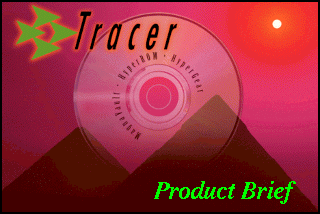 Tracer HyperROM software
Tracer HyperROM software
Product Information
You are considering the purchase of a CD-ROM jukebox because you need
to access a large volume of CD-ROM data. Regardless of the application,
you are concerned about the overall performance, network access, security
and ease of management. Tracer Technologies would like to introduce you
to
the HyperROM file system for CD-ROM drive arrays, mini-changers
and jukeboxes, new technology for CD-ROM.
HyperROM makes it look like all the optical media in your
jukebox are mounted and transparently schedules access to the optical drives.
This means
that your application software does not need to know that there is
a jukebox behind the scenes; instead, you can simply access data using
the same
system calls and utilities that you would normally use. Most operating
systems provide a way to access a single CD-ROM drive, using either ISO
9660,
HighSierra/RockRidge, or native UNIX discs. The problem is that the
methods that work for a single CD-ROM drive do not scale up to meet your
needs for simultaneous multi-disc applications.
HyperROM provides an intelligent new way to access the
same CD-ROM data, but specifically designed to provide high performance
for hundreds of
CD-ROM discs. HyperROM makes every CD-ROM disc contained
in the subsystem appear to be mounted and available. An intelligent scheduling
algorithm provides transparent access to all the available CD-ROM drives
contained within the array, mini-changer or jukebox. Applications and users
simply access data using the same system calls and utilities normally
used, transparently. You don't need to do anything special to use HyperROM.
HyperROM allows you to mount a large number of CD-ROM
discs on your host UNIX system without the massive platter-changing overhead
typically
found in a jukebox management subsystem. A standard file system , magnetic
disk-based database contains and caches all the CD-ROM inode &
metadata (directory & file attribute information) that is used
for all directory operations and file lookups. This means that users can
browse through the
entire catalogue of CD-ROM discs without causing discs to be loaded
or exchanged. A tunable file migration scheme is provided to speed access
to your
data. Once you access a file within a specific directory, HyperROM
"rolls in" a portion of each file in that directory into the magnetic cache
file. Once a
CD-ROM is loaded into a drive, it is operated continuously at its'
maximum sustained data transfer rate to speed up the operation of application
tools
such as image browsers.
HyperROM is capable of operating all drives contained
in the CD-ROM subsystem simultaneously, thus providing astounding aggregate
data transfer
rates from today's high-speed CD-ROM drives. HyperROM
utilizes an LRU (least recently used) caching algorithm that will automatically
maximize your
magnetic cache disk space. HyperROM's flexible caching
scheme allows you to designate how much cache you want for each individual
CD-ROM file
system, so that your most important discs exhibit the best possible
performance.
System management with HyperROM is easy with our AutoJuke
management tool. It's easy to see what CD titles are loaded and mounted,
as well as
tracking CD's that are no longer contained within the CD-ROM subsystem.
HyperROM also offers an aggregated, single mount point for
NFS exporting
of the entire CD-ROM subsystem to NFS clients, or as a UNC pathname
or single drive letter to Lan Manager clients. An optional SPX/IPX for
NetWare interface is also available. Offering seamless integration
with all your existing applications, HyperROM is truly CD-ROM
management software
for the new millenium.
FEATURES:
Supported Devices:
Tracer Software supports a huge range of optical, CD and Tape devices,
both standalone and jukebox. Manufacturers include...